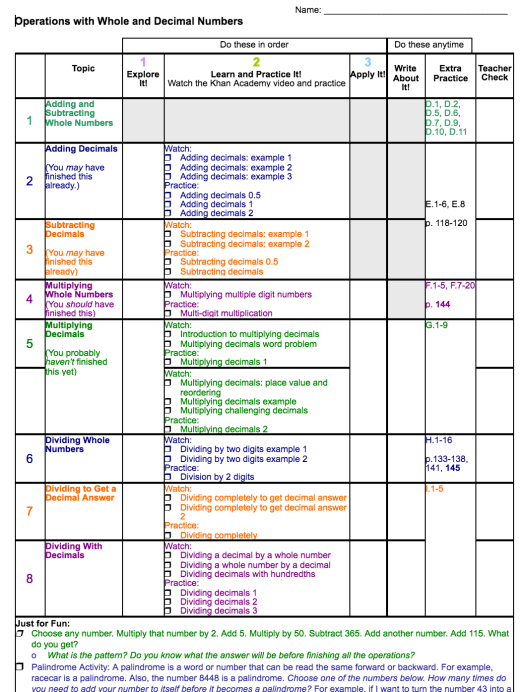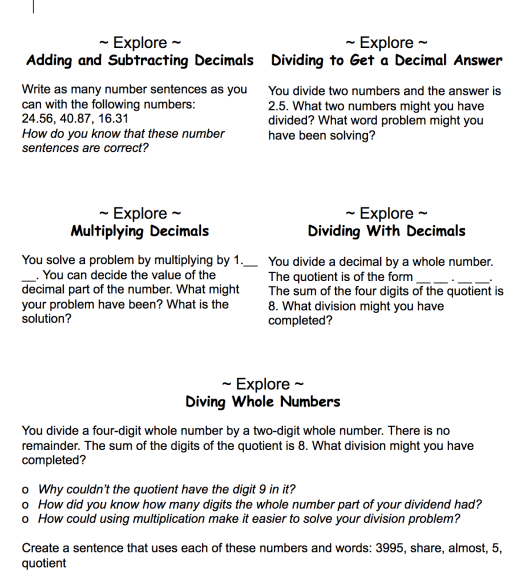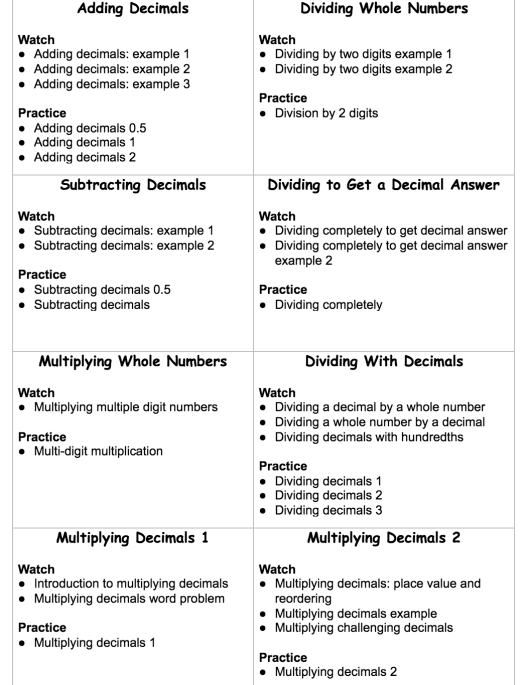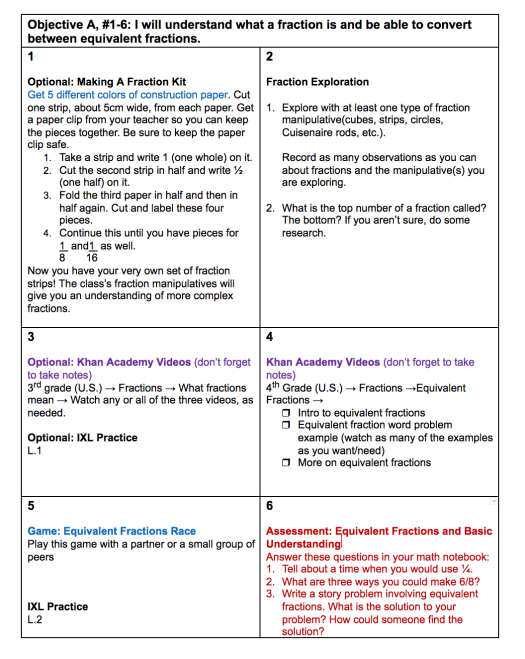Let me start by pointing out that, while this post talks about math specifically, the ideas within can certainly be applied to other subject areas.
One morning, I was having a chat with one of the middle school math teachers, who was very much an out-of-the-box thinker like myself. He had this pathway posted on the wall of his classroom, and different “stops” along the way. Students had a learning plan, where they watched a video, worked on some activities, and when they were ready for the test, they let the teacher know. If they were ready to move on, they’d move down the pathway.
It was a great discussion, and I really enjoyed having my thinking challenged. I immediately had ideas for how I could adapt this system to work in my fifth grade classroom with my amazing group of students (all my students are amazing, by the way). So I immediately got to work and the rest of the year would have my students and I testing out and improving upon a version of this system.
So what system did we come up with?
Well, it’s not final. Nothing in education is ever final, and this certainly still has lots of room for improvement. But it’s come a long way! Since my students and I worked together to set up our learning environment at the beginning of the year, it follows that we worked together to try out this system-in-progress, and continually improve it. Here’s how our journey went:
1. The way-too-advanced table
First, I created this amazing table that was super organized with different sized columns and rows, checkboxes, a variety of colors, and shading. It adhered to what the PYP believes about how students learn math, and was sure to be a success. I paired it with activity cards for the Explore it! and Apply It! sections, that the kids could get when they were ready for them.


It would have been a great learning exercise for my students to figure out how to effectively use the table (and pair the table with the cards), and I’m certain they were capable, but they were just small children, after all. After a while of trying it, we decided it wasn’t worth the effort to figure this thing out, and moved on to the new and improved version of the table. In hindsight, it seems so obvious that preparing 20 grade 5 students to read tables like this would have been a huge task in and of itself. Oops!
2. Cards-only
The students responded much more positively (they were a lot less confused!) to this table-replacement:

All I did was take the content of my fancy-pants table and separate it into easy-to-read instruction cards with a bigger font. Now the entire format was card-based. I pinned the cards, one for each student, on our path-on-the-wall, and students just had to start at the left, and continue to the right, grabbing cards along the way.
They were supposed to secure each card in their notebook with glue or tape. This posed numerous problems as students often didn’t have their own glue, the paper would fall out, or students would simply misplace these small sheets of paper. In the end, we ended up not having enough cards for everyone, and I was stressed to fix it (especially when this discovery happened in the middle of a class and I could leave to go print more). It wasn’t a bad system, and with a little more time and effort, we probably could have made it work. But I was also starting to think about how I would fit the next unit of cards onto the now-full wall. Some students were ready to move on, and some still needed the cards on this wall. We just didn’t have enough space for it all!
3. Single-page with all learning activities, objective, and assessment
It was time to get some formal feedback anyway. So, I held a feedback session with the students and, based on their comments and suggestions, I came up with this:

Essentially what I did was take the card system, put all the ‘cards’ onto one single piece of paper, and printed a page for each student. We spent some time figuring out what students could do with the paper to ensure they wouldn’t lose it because “This is the most important paper in math class!”.
You’ll notice that this new version also included a specific objective, which I had used in planning all of this, so it only made sense to share it with students. Some sections included, as one of the activities, a journal entry that involved reflecting on the objective and their learning. Also, cut-off from this image, was a space for student, teacher, and parent to all sign-off when a student had achieved the proposed learning and was ready to move on. For parents, it was more of a simple way to encourage students to share their learning with their parents and for me to know that parents are being kept in the loop.
The activities were a mix of open-, guided-, and structured-inquiry activities, with extra practice activities (from the IXL website) listed. Khan academy videos were strategically placed after students had dabbled in a topic, to solidify the knowledge and transfer the meaning they were beginning to construct. After the video, there was at least one game or activity to practice the new skill(s), followed by an evaluation that students could complete when they were ready.
That’s right – I let them see the “test” at the beginning!
Assessment
Students knew exactly what was coming. We spent so much time talking about the purpose of education and school, and I did everything I could to model a growth mindset. I had so much confidence in my students that I trusted they would not take this paper home to an older sibling, for example, and get the answers ahead of time. That being said, I also conferenced with each student before signing off on their learning and giving them the next page. The conference was a part of the assessment and, regardless of what their notebooks said, students would not move on if I didn’t see them demonstrate their understanding of the concepts. The written-assessments were meant to be done independently and I think most students, most of the time, did this. They respected the purpose of the assessment and the purpose of being in the class (to learn).
Conferencing with every.single.student?
Conferences
It actually wasn’t too difficult to meet with each student. In a traditional classroom, all students work on an activity at the same time, complete the test at the same time, etc. So in a traditional classroom, children are likely to need teacher support at the same time. One of the reasons written tests are seen as necessary is that it’s a quick and simple way to get assessment data on all students. But with everyone working at their own pace, on something different, my time was much less in-demand at any given time. Only a few students would need assessment-conferencing in one day. There were some times when students were waiting and, in future, I’ll try to set them up better to effectively use that wait-time. All-in-all, it worked pretty well, though.
It may seem like just a checklist, but it was so much more!
Going Deeper
Now that I’m (finally) writing about this experience, it seems so robotic, so simple. But it was anything but. Activities sometimes took several days to work through, and students often came up with their own questions to guide their learning. They chose to help others as a way to solidify their learning (and to help their peers, of course). If I felt a student needed some extra practice, I’d ask them more questions, give them more activities/games to explore, or have students create challenge questions/activities for each other. It became less a checking-of-the-boxes, and more using-the-sheet-to-guide-your-learning. I also had some full-class activities that allowed everyone to work on the same problem, regardless of their current learning. I have to really think about what the class atmosphere was like to remember that it wasn’t just checking the boxes like it may seem.
So what was it like?
Classroom Atmosphere
Students were free to work on their own or with others in a space that suited them, with whatever tools worked for their learning. We were constantly discussing and improving the system, so we came up with a sub-system for students who needed support. They could write their name in a certain section of the whiteboard if they wanted to conference with another student. Or they could write it in another section of the whiteboard to conference with me. I would make my way around the classroom to conference with all students whose names were on the board. If anyone approached me whose name wasn’t on the board, I would direct them to ask a classmate first or give it some (more) time independently. This became so natural to them after a while that I rarely had students coming to me without signing up. Another variation of this that also worked was the use of color-coded cards (pieces of paper). Cups would have probably worked better but were not available in Kuwait. One green, one yellow, and one red card (or cup) for each student/group of students. If a students was displaying the green card, all’s good – no help needed. If the yellow card was showing, the student could use some support but it wasn’t urgent. If the red was showing, the student had an urgent question and needed teacher support. This ensured that students didn’t spend time waiting in a line-up or raising their hand for several minutes. They were able to make it known they needed support, and then continue on with something else.
We also had student experts. When I observed that a student had an especially thorough understanding of a concept or was able to explain/teach it in a clear manner, I would write that student’s name in the “expert” section of the whiteboard. A struggling student could approach an expert for support. This system allowed students to shine, regardless of where they were in their learning journey. In a traditional classroom, the student-who-finishes-first kind of becomes the go-to (if only because the teacher doesn’t know what to do with the student). But just because a student finishes first doesn’t mean they have the most expertise or are the best to be helping other students (and, in many cases, the opposite is true). Students were always proud to be an expert and, in the end, each child was an expert in something!
At any given time, if you were to walk into our class, you would see students working in groups, pairs, or independently. You’d see students using a variety of learning tools:
- writing in their notebooks
- writing on whiteboards (individual or the ones on the walls)
- watching videos (with headphones) on their devices (phones were allowed for video-viewing) or the class computer
- discussing with their peers or with me
- using manipulatives
- playing games
Students had a variety of learning space options:
- sitting in a chair
- sitting on the floor
- laying on the floor
- standing
- inside the classroom or in the hallway (numbers controlled by me)
- on some days, we were able to work outside, or I was able to send a small group of students to another space, depending on supervision options and their ability to work independently at that point in their learning journey
I was usually:
- sitting on the edge of a desk
- sitting on the floor
- asking questions
- listening to students
The freedom of spaces and styles suited most students and their engagement was incredible. Students were discussing, asking questions, and problem-solving. I was there to set them up and support them along the way. A true guide-on-the-side.
So much more than “just math”.
Other Skills
Upon reflecting, I realize that there was so much more learning than just the math. Students were constantly thinking critically to help improve our system. They were improving their research skills in finding answers to their questions. They were taking risks, and reflecting on those risks and their learning. They were communicating and cooperating with other mathemeticians in the class, and they were gaining confidence and independence. Finally, in all their questioning, researching, discussing, and more, they were being true inquirers.
Final thoughts
One comment I’ll never forget, came with a huge smile and loads of excitement:
“Miss, I used to hate math. This year, I love it – it’s so much fun!” (and I knew she was learning tons, too!)
Of course, there’s still lots of room for improvement. I can’t wait to try something like this out again when I get back into the classroom and work with a new group of students to find a system that works for them.
I would love to hear your thoughts – as an educator, a student, or a parent – on this type of stand-alone learning (where the content is not taught as part of a cross-disciplinary unit/unit of inquiry?

One Reply to “”